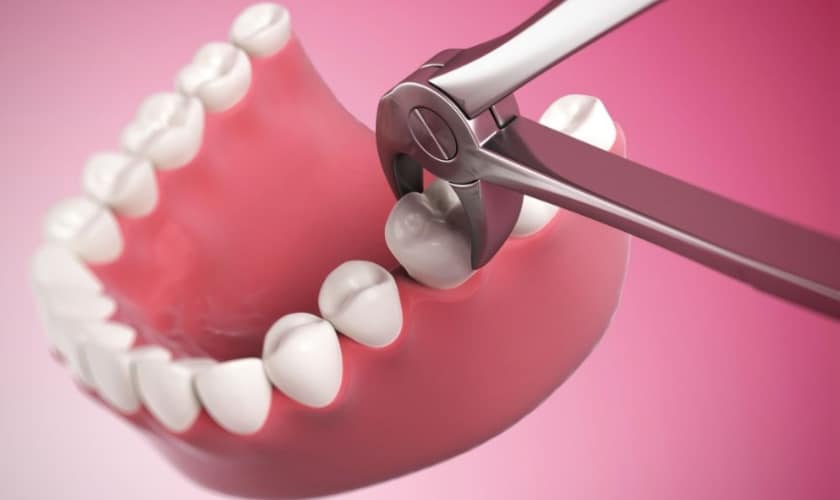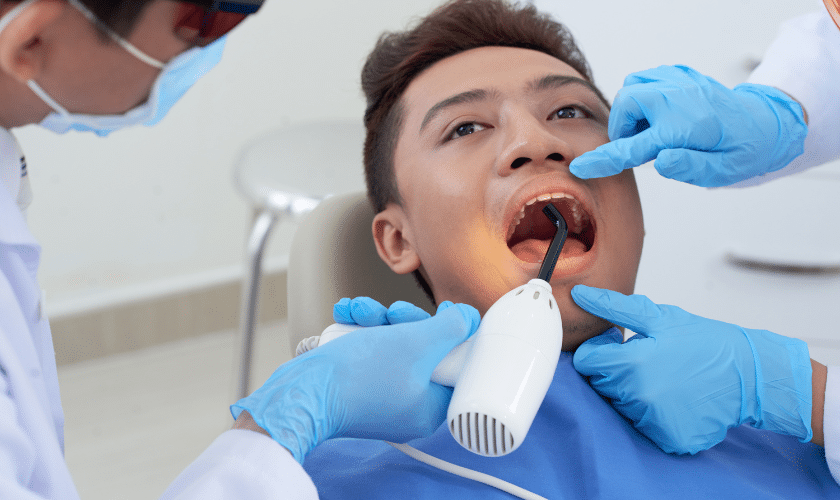ONLINE SCHEDULING AND VIRTUAL CONSULTS AVAILABLE

Recovery From Wisdom Tooth Extraction- Timeline And Tips

The process of recovering from wisdom tooth extraction is a significant phase that requires careful attention and meticulous care. It involves the removal of one or more wisdom teeth, typically located at the back of the mouth, due to issues like impaction, overcrowding, or infection. While wisdom tooth extraction in Plantation, FL, is common and generally safe, the post-operative recovery period is crucial for ensuring optimal healing and minimizing discomfort.
This detailed guide aims to provide a comprehensive understanding of what to expect during the recovery timeline after wisdom tooth removal. The recovery journey after wisdom tooth extraction may differ from person to person, but by being well-informed and following essential guidelines, individuals can promote a smoother and more comfortable healing process.
Understanding Wisdom Tooth Extraction
Wisdom tooth extraction is a common dental procedure that involves removing the wisdom teeth found at the back of your mouth. These teeth are the last ones to come in and often cause problems like pain, overcrowding, or getting stuck in your jawbone. Dental professionals recommend wisdom tooth extraction in Plantation, FL, when they’re causing pain, damaging nearby teeth, or leading to infections.
Sometimes, these teeth can’t grow properly due to lack of space in the mouth, causing them to be impacted or trapped beneath the gums. After the extraction, there might be some bleeding, and you may experience swelling and mild discomfort. Following your dentist’s post-operative care instructions is crucial to ensure proper healing.
The Initial Recovery Phase (Days 1-3)
Right after the wisdom tooth extraction, usually, for the first three days, you might notice some bleeding from the extraction site. This is normal, and you can manage it by gently biting on a clean gauze pad placed over the area.
During these initial days, swelling around the extraction site is common. To reduce swelling, you can apply an ice pack wrapped in a cloth to your cheek outside the treated area. It helps ease the discomfort and reduce the swelling.
Eating soft or liquid foods during these initial days is helpful since your mouth might feel sensitive. Avoid hot and spicy foods, as they can irritate the extraction site.
It’s crucial to avoid activities that could dislodge blood clots, such as using straws or rinsing your mouth vigorously. These clots are important for the healing process, so take care not to disturb them.
Days 4-7: Managing Discomfort and Healing
During days 4 to 7 following wisdom tooth extraction, you might notice a reduction in swelling compared to the initial days. However, some discomfort or mild pain could persist. As a result, it can typically be managed with prescribed pain medications.
Continue with a diet consisting of soft foods during this period. Foods like mashed potatoes, yogurt, or smoothies are gentle on your healing mouth. Avoid crunchy or hard foods that might irritate the extraction site.
If your dentist prescribed antibiotics, make sure to complete the full course, even if you start feeling better before finishing them. This helps prevent any potential infection from developing. You might notice some dissolving stitches if they were used during the extraction. Don’t be alarmed if they start to come out during this time; it’s part of the normal healing process.
Days 8-14: Signs of Healing
During days 8 to 14 post-wisdom tooth extraction, you may notice a significant reduction in swelling and discomfort compared to earlier stages of recovery. At this stage, the extraction site begins to heal visibly. The gum tissue around the area might start closing, indicating the initial stages of the healing process. Also, any lingering discomfort is notably lessening.
If dissolvable stitches were used, they might start to fall out or dissolve during this period. This is normal and part of the healing process. However, if you have non-dissolvable stitches, your dentist will remove them during a follow-up appointment.
Continue maintaining good oral hygiene by gently brushing your teeth and tongue and taking care of the healing area. Rinsing with saltwater remains beneficial in keeping the extraction site clean and promoting healing.
Weeks 3-6: Complete Healing
Significant progress toward complete healing is expected between weeks 3 and 6 after wisdom tooth extraction. During this phase, the extraction site continues to close and regenerate, indicating the final stages of the healing process. Any residual discomfort or swelling from the extraction usually subsides by this time. You might notice that the gum tissue surrounding the extraction site looks more settled and less inflamed.
Maintaining good oral hygiene remains crucial. Brush your teeth gently, ensuring you pay attention to the area around the healing site. Continue rinsing with salt water or using a prescribed mouthwash as advised by your dentist to keep the area clean.
Activities that were avoided during the initial recovery phase can be resumed around this time. However, it’s essential to listen to your body and avoid activities that cause discomfort or strain on the healing site.
Essential Tips for a Smooth Recovery
Follow Post-Operative Instructions: Adhere strictly to the guidelines provided by your dentist or oral surgeon. These instructions typically include caring for the extraction site, taking prescribed medications, and dietary restrictions.
Maintain Good Oral Hygiene: Gently brush your teeth twice a day, paying extra attention to the extraction area. Rinse your mouth with salt water or a prescribed mouthwash to keep the site clean and prevent infections.
Stick to Soft Foods: During the initial days after extraction, opt for soft foods such as soups, yogurt, mashed potatoes, and smoothies. Avoid hard, crunchy, or spicy foods that could irritate the healing site.
Manage Discomfort: Use prescribed pain medications as directed to alleviate discomfort. Applying an ice pack to the cheek outside the treated area can help reduce swelling and ease discomfort during the initial recovery phase.
Avoid Disturbing Blood Clots: Refrain from using straws and vigorous rinsing, as they can dislodge blood clots crucial for the healing process. These clots protect the extraction site and promote healing.
Attend Follow-Up Appointments: Keep your scheduled appointments with your dentist for check-ups and removal of stitches if necessary. These visits allow the dentist to monitor your healing progress and address any concerns.
Stay Hydrated: Drink plenty of water to stay hydrated throughout your recovery period. Avoid alcoholic and caffeinated beverages that can impede healing and cause dehydration.
The recovery journey following wisdom tooth extraction is a multifaceted process that necessitates patience, care, and adherence to post-operative instructions. Understanding the stages of recovery, from gradual healing over weeks, is crucial for individuals undergoing this dental procedure. Moreover, seeking immediate dental advice in case of unexpected complications or prolonged discomfort is vital to ensure optimal healing and prevent potential complications. Visit us at My Dentist For Life Of Plantation for wisdom tooth extraction in Plantation, FL. With the help of a detailed assessment and your oral health evaluation, we’ll help you determine if you need this dental procedure. Call us today and schedule an appointment!




